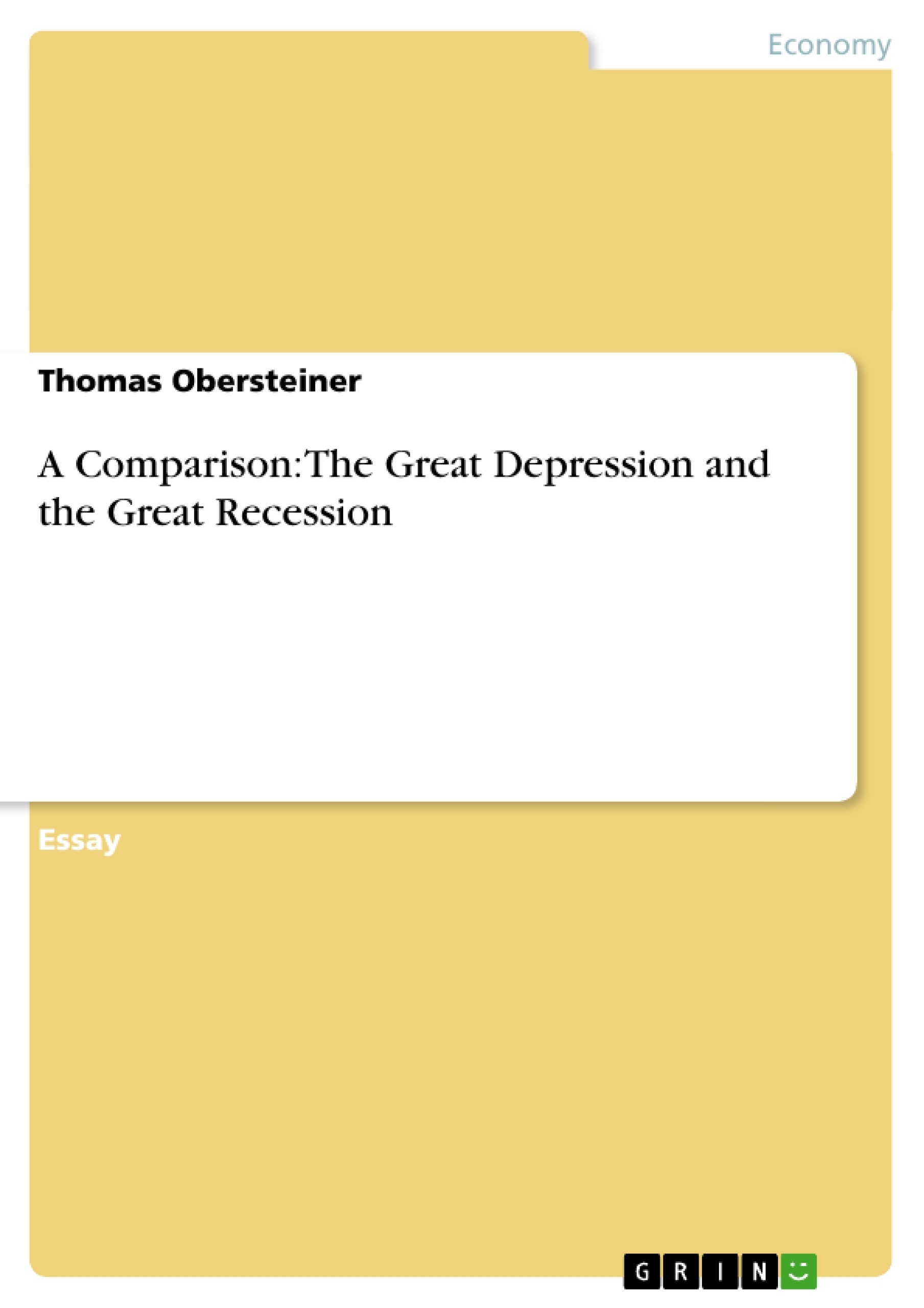This paper compares the situations that led to the Great Depression (GD) and the Great Recession (GR). Explanations for these crises differ among economic schools, but there is some agreement on fundamental causes.2 In the following, several aspects of the economic environment prior to the outbreak of the GD and the GR will be examined and the parallels and distinctions demonstrated.
1. Introduction
This paper compares the situations that led to the Great Depression (GD) and the Great Recession (GR).1 Explanations for these crises differ among economic schools, but there is some agreement on fundamental causes.2 In the following, several aspects of the economic environment prior to the outbreak of the GD and the GR will be examined and the parallels and distinctions demonstrated.
The most obvious similarity is that both events originated in the United States (US) and became a global phenomenon through global capital flows and trade.3
2. Illusions, dynamics and asset bubbles
During the late 1920s, the global economy went through a period of economy growth and prosperity. The invention of new technologies, large corporate profits and constantly increasing stock prices created enthusiasm. According to Chernow, investors believed in an “era of permanent prosperity” and in unwavering growth. US- banks, then the world’s leading creditors, happily supplied capital to borrowers around the globe. However, this bullish environment also provided the breeding ground for asset bubbles (price of a good exceeding its intrinsic value due to speculation and dynamics), which finally burst in early 1929. The sharp and rapid decline of asset prices led consumer and firms to simply stop spending.4 Although the infamous stock market crash in autumn 1929 was the most remarkable single event, it happened at a time when other asset prices had already plummeted.
A similarly naïve mindset preceded the current crisis. Many types of asset-backed securities (ABS, securities collateralized by an asset) were considered overly safe. Trust in some US and European real property assets was particularly high. Rating agencies and investors assumed that it was virtually impossible for their value to decrease and lenders started handing out mortgage loans (loans collateralized by property) even to formerly non-credit-worthy borrowers. Thus, demand for property increased and so did prices. During 2007, when almost everyone who desired a house owned one, demand slowed down. Simultaneously, the default rate among US sub- prime borrowers (the least credit-worthy debtors) increased (figure 1) and foreclosures (lender recovers the property and puts it up for sale) became more frequent. The situation deteriorated when US house prices plunged (figure 2) and the bubble burst. The crumbling of prices in real estate and its derivatives (securities with a value derived from an asset) indirectly led to fire sales in all other asset categories (asset meltdown). These events trigged what is commonly called the worst recession since the GD.
3. Living beyond the means
“The decade witnessed an explosion in sales of cars and radios, refrigerators and washing machines, all made affordable by installment plans”, writes Ron Chernow about the time before 1929.
Similarly, US consumer spending during the decade before 2008 reached unrecorded levels (figure 3) while the personal savings rate decreased constantly (figure 4). A “wealth-effect” (rising asset prices entice people to spend more) blew up the asset bubble. In contrast to the GD, this spending binge was funded by foreign capital (see 6.). The fact that the bubble was heavily build on borrowed money made it worse than other bubbles, e.g. the dot.com bubble, as it resulted in early fire sales, painful debt restructuring and complex bankruptcy proceedings.5
4. Banking failures, credit crunch and uncertainty
During 1929 and 1930 the number of US financial institutions decreased by almost 50% and banks were collapsing at a rate of one per day.6 It remains disputed what exactly caused the banks to fail but conceivably the decline in asset prices and high failure rates (debtors not able to pay back loans), especially in the agriculture sector, initiated bankruptcies in early 1929.7 Contagion of fear and uncertainty provoked bank runs (depositors attempting to convert their deposits into currency), which further stressed financial institutions. This environment had two devastating consequences: first, the collapse of money supply as argued by Milton Friedman and Anna Schwarz8 and second, a collapse of lending as argued by Ben Bernanke.9 When banks ceased lending, the real economy lacked its fuel (credit) and stopped to invest. This put pressure on the labor market (lay-offs) and consumption (lower income) declined further, causing even more bankruptcies and defaults on loans. During the years of the GD, countries around the globe were trapped in suchlike vicious circles.
In 2008, distressed banks played an even bigger role. Starting from 2007, many banks incurred huge losses through write-downs regarding ABS and mortgage loans on their own balance sheets.
- Citar trabajo
- MMMag. Thomas Obersteiner (Autor), 2011, A Comparison: The Great Depression and the Great Recession, Múnich, GRIN Verlag, https://www.grin.com/document/167932
-

-

-

-
¡Carge sus propios textos! Gane dinero y un iPhone X. -

-
¡Carge sus propios textos! Gane dinero y un iPhone X. -

-
¡Carge sus propios textos! Gane dinero y un iPhone X. -

-
¡Carge sus propios textos! Gane dinero y un iPhone X. -

-
¡Carge sus propios textos! Gane dinero y un iPhone X. -

-
¡Carge sus propios textos! Gane dinero y un iPhone X. -

-
¡Carge sus propios textos! Gane dinero y un iPhone X. -

-
¡Carge sus propios textos! Gane dinero y un iPhone X. -

-
¡Carge sus propios textos! Gane dinero y un iPhone X. -

-
¡Carge sus propios textos! Gane dinero y un iPhone X.

